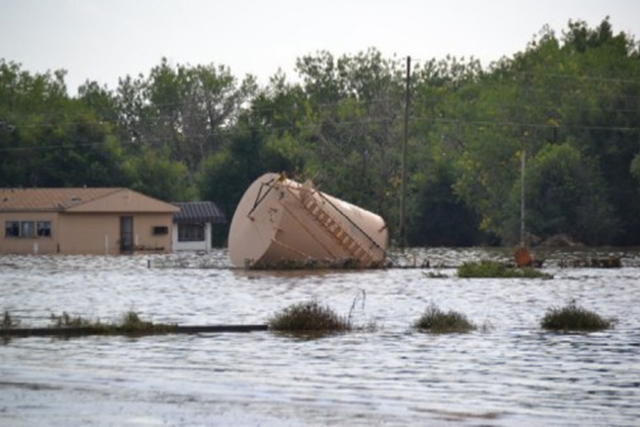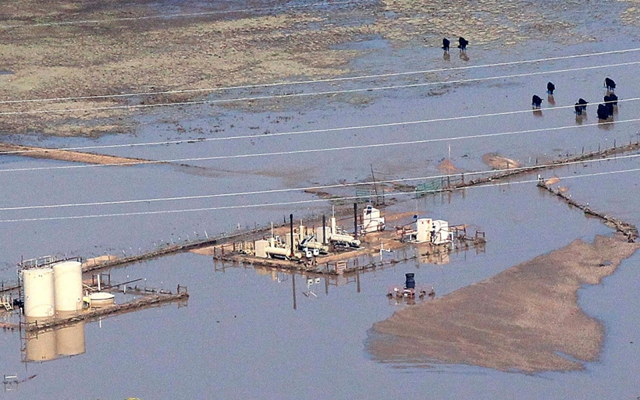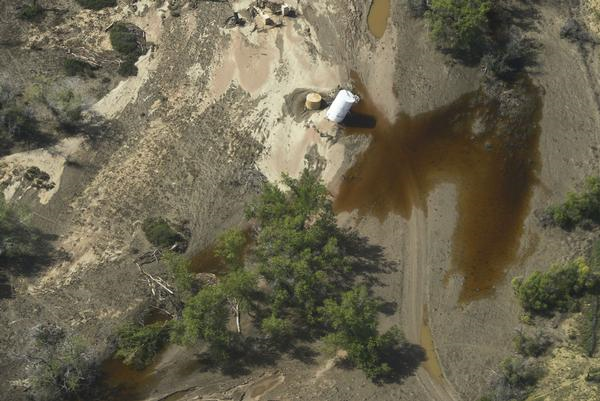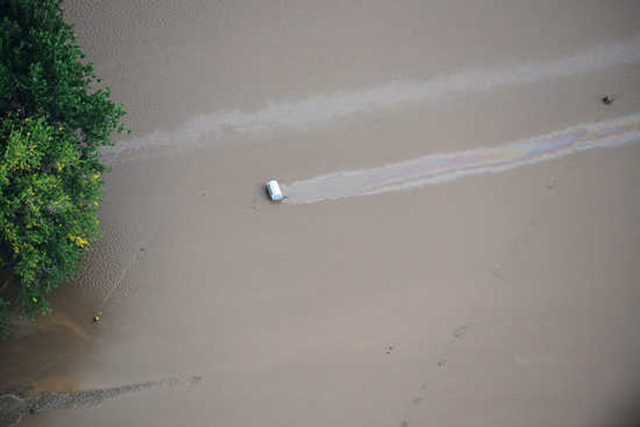Thousands of oil and gas wells underwater in Colorado – State monitoring 10 separate oil and gas spills
Patrick J. Kiger
19 September 2013 (National Geographic) – In the wake of unprecedented massive flooding over thousands of square miles in Colorado, government officials and private companies are rushing to secure the region’s heavy concentration of oil and natural gas wells, and prevent dangerous chemicals and toxic waste from contaminating the region’s water. (See related quiz: “What You Don’t Know About Oil Spills.”) Late Wednesday, reports emerged that at least 5,250 gallons of crude oil had seeped into the South Platte River in the north-central part of the state. The oil was leaking from damaged Anadarko Petroleum tanks. “Anadarko is responding and has absorbent booms in the water,” said a statement from the state’s Department of Natural Resources (DNR). Another report noted that Noble Energy was seeing a “limited amount of natural gas” leaking from one of its wells. (See related story: “As the Arctic Melts, a Race to Test Oil Spill Cleanup Technology.”) Inspectors have yet to reach many of the well sites, in part because many roads remain inaccessible, according to Todd Hartman, a spokesman for the Colorado DNR. “You have operations that are entirely underwater,” Hartman said.
In the meantime, crews are monitoring the wells by air and from boats, and also relying upon pressure sensors to remotely monitor conditions inside the wells, according to Colorado Oil and Gas Association president Tisha Schuller. (See related photos: “Oil Spill Sullies Popular Beach in Thailand.”) “As soon as they can get in, they’re going in,” Schuller said. It remains unclear exactly how many wells have been affected by the flooding, but the association says that nearly 1,900 wells have been “shut in,” meaning that operators have stopped the flow of oil and natural gas to prevent leakage. Crews had to be on-site to shut down some of the wells, while others were equipped for remote shutdown, Schuller said. But although no wells appear to be leaking, there are even more serious potential worries, said Amy Mall, a senior policy analyst with the Natural Resources Defense Council in Washington, D.C. Well sites often contain tanks of toxic wastewater and supplies of potentially hazardous chemicals used in the drilling or extraction processes, which might be damaged by floodwaters and spring leaks. The sites also contain what Mall called a “spider web” of myriad pipes connecting the wells to tanks or processing equipment, any of which potentially can fracture. If such failures occur, these substances could be picked up by floodwaters, and then contaminate streams, rivers, reservoirs, and other bodies of surface water, Mall said. [more]
Colorado Flooding Imperils Oil and Gas Sites, Causes Spill 
14 September 2013 (Weld Air and Water) – Photo gallery of flooded oil production facilities in Colorado after the massive flooding of September 2013.
Flooding on South Platte and Cache la Poudre 
By David Mitchell and Eli Stokols
18 September 2013 MILLIKEN, Colorado (KDVR) — The initial fears of residents, concerned about toxic pollution from thousands of flooded oil and gas wells across the northern Front Range, continue to be confirmed. After Wednesday’s report that a damaged oil tank had dumped more than 5,000 gallons into the S. Platte River south of Milliken, Noble Energy Thursday reported that it has found three wells that are leaking natural gas. Later, the corporation reported that another tank has released 13,566 gallons more. In total, the state is tracking 10 oil and gas spills related to the flood, officials said. Two wells were shut on Wednesday, but a third that appeared to be leaking a “limited” amount of gas couldn’t be accessed for shutdown, according to the company. Anadarko Petroleum Corp. reported the tank that’s leaked 5,250 gallons of crude oil to the state’s Department of Natural Resources, which is a required by law, on Wednesday. “A release of oil into our rivers is of course enormously troubling,” Conservation Colorado’s Pete Maysmith told FOX31 Denver on Thursday. “There’s the concern for fish and wildlife, not to mention the possible impact on our drinking water.” The Colorado Oil and Gas Conservation Commission (COGCC) says Anadarko is responding and has oil-absorbing booms in the water at a location south of Milliken and north of the confluence of the St. Vrain and S. Platte rivers. The COGCC along with the Colorado Health Department is monitoring the cleanup of the 5,250 gallons of oil. “I expect, as flood waters recede, we’re going to see more of these kind of incidents, but they’re on a scale that can be managed,” said Tisha Schuler, the CEO of the Colorado Oil and Gas Association, who noted that there are millions of gallons of raw sewage in the flood waters, compared to some reported 19,000 gallons of oil. “On a scale of the kind of flooding we’re talking about, these are relatively minor impacts,” she said. “That said, they’re still important. And we will respond and clean them up immediately.” Residents across the northern Front Range have been concerned about possible pollution from oil and gas wells, with much of the Denver-Julesberg basin under water. “We probably shouldn’t have had the oil and gas development in a flood plain to begin with,” said Carl Erickson, with the group Weld County Air and Water. “That would have been the prudent thing. “But, it’s done now. Now we have deal with the result of having made that decision.”
State following 10 separate oil and gas spills related to flooding 
By Renee Lewis
18 September 2013 (Al Jazeera) – As Colorado reels from a prolonged flooding disaster that has killed at least eight people and left hundreds unaccounted for, environmental groups warn of potential contamination by ruptured oil and gas industry infrastructure. In Weld County, which has seen some of the worst of the rains, activists point to photos of destroyed wells, tanks and pipelines posted on social media sites. They claim that years of “fracking,” the process of drilling for shale gas through hydraulic fracturing, has made the area northwest of Denver and Boulder vulnerable to contamination in the event of flooding. “Weld County, where the South Platte River has been flooding uncontrollably, has almost 20,000 active oil and gas wells,” Gary Wockner, Colorado program director for Clean Water Action, told Al Jazeera. “It’s the most heavily drilled county in the U.S., and it’s seeing some of the worst flooding,” he said. “Oil and gas and chemicals associated with drilling are going to be spread across a wide swath of landscape.” The latest flood began last Wednesday, triggered by unusually heavy late-summer storms that drenched the northeastern part of Colorado. Along with Weld, the counties of Boulder, Adams, Jefferson and Larimer have been the worst hit. There are hundreds of active oil and gas wells built in the South Platte River floodplains alone that are at risk of contaminating the floodwaters. Already there have been reports of a ruptured natural gas pipeline and overflowing crude-oil wells. By Wednesday evening, the Denver Post was reporting that crews had placed absorbent beams into the South Platte River south of the town of Milliken, where it said 5,250 gallons of oil had spilled into the river. Ahead of that news, industry representatives had attempted to downplay any risk, suggesting that the pictures of broken pipes and underwater wells amount to a “social media frenzy.” Tisha Schuller, president of the Colorado Oil and Gas Association, testified before the Colorado Oil and Gas Conservation Commission regarding the industry’s response to the historic floods, which have forced the evacuation of more than 10,000 people. “All impacted wells have been shut in, which means the well has been closed off or shut and is not producing any oil and gas product,” Schuller said in a release. Schuller also responded to controversial photos that Colorado residents have uploaded to social media sites showing floating tanks, blowouts and flooded infrastructure. “We have seen the social media frenzy regarding pictures of oil and gas facilities ‘under water,'” she added. “While the pictures seem extraordinary, there is no data or specifics provided.” [more]
Flooded oil and gas wells spark fears of contamination in Colorado 
By Mark Jaffe and Bruce Finley
19 September 2013 (Denver Post) – Rushing floodwaters loaded with heavy debris damaged oil and gas pipes and tanks, causing the two large spills that state and federal regulators were tracking Thursday. Another eight releases, whose cause is undetermined, were classified as minor by the Colorado Oil and Gas Conservation Commission — sheens, for example, coming off of a piece of equipment rather than a measurable volume of petroleum product. Anadarko Petroleum Corp. on Wednesday reported the two larger releases in Weld County. About 125 barrels — or 5,225 gallons — spilled into the South Platte River near Milliken. A tank farm on the St. Vrain River released 323 barrels — or 13,500 gallons — near Platteville. Both releases involve condensate — a mixture of oil and water — according to Matthew Allen, a spokesman for the Denver office of the Environmental Protection Agency. “We are back in the field today looking for ongoing releases,” Allen said. “So far, we haven’t found any of those.” State law requires oil and gas equipment in the floodplain to be anchored to resist flotation. The Anadarko tank moorings held, company spokesman John Christiansen said, but strong waters and heavy debris appeared to have cracked pipes and manifolds, allowing the condensate to escape. Anadarko was able to get absorbent booms and a vacuum truck to the Milliken site and collect about 40 barrels’ worth of the 165 that had spilled, Christiansen said. But floodwaters kept crews from reaching the tanks on the St. Vrain quickly. “By the time we got there, they were empty,” he said. The state oil and gas commission is trying to compile a comprehensive list of facilities in the flooded areas and their status, including what chemicals they had on site. Companies are required by state law to report spills within 24 hours. “But they are moving faster than that with the flood,” said Todd Hartman, a spokesman for the oil and gas commission. Gov. John Hickenlooper, during a Thursday news conference on flood recovery, said the spills “weren’t excessively large.” “The several small spills we’ve had have been very small relative to the huge flow of water coming through,” he said. The Denver Post on Thursday morning flew over the spill site south of Milliken. The site is near the confluence of the St. Vrain and South Platte, which overflowed their banks last week, flooding the towns of Milliken and Johnstown about 5 miles to the north. From the air, two orange absorbent booms were visible across floodwaters around a cluster of listing beige storage tanks. Less than a quarter-mile away, black material was flowing from a toppled white tank into the muddy waters of the South Platte. There were no booms around that tank. No industry or state crews were visible at either location. According to an update Thursday from the oil and gas commission, the state had six teams of inspectors and environmental-protection specialists in the South Platte River valley looking for spills and damage and assessing environmental impact. [more]
State now tracking 10 oil and gas spills in Colorado flood zones

